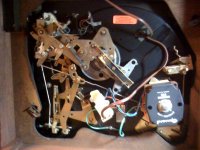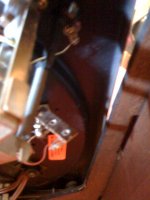Hello,
This is my first post. I just found an old Garrard SL72b without RCA outs. I'm wondering how to go about soldering these in, and where? This will be my first attempt at this, and it's kind of just for fun anyway, to rebuild this thing.
I've included a picture, if someone could circle maybe where they go, and give me a basic idea of what to do? I would love it!
Thanks a ton!
Joe
This is my first post. I just found an old Garrard SL72b without RCA outs. I'm wondering how to go about soldering these in, and where? This will be my first attempt at this, and it's kind of just for fun anyway, to rebuild this thing.
I've included a picture, if someone could circle maybe where they go, and give me a basic idea of what to do? I would love it!
Thanks a ton!
Joe
Attachments
Joe, I looked at the picture and can't see where the wiring from the cartridge is. That's what you have to find. Should be four wires to go to two cables or jacks; cables are easier. You take a stereo RCA both ends cable (or a nice long monaural cable) and cut off the plugs on one end (or in the case of single cable, cut it in half).
Then you strip the insulation off the ends and connect to the tiny wires coming from the tone arm. Best to use a terminal strip but you may already have one in there.
Then you strip the insulation off the ends and connect to the tiny wires coming from the tone arm. Best to use a terminal strip but you may already have one in there.
Connection points
Joe, Look just to the left of the orange sticker on the picture. You will see some thin wires attached to something mounted to the under side of the record player by a silver colored strip. This looks like a pretty standard solder lug terminal strip. If so, this is where your RCA leads get soldered to.
Good luck,
Bill
Joe, Look just to the left of the orange sticker on the picture. You will see some thin wires attached to something mounted to the under side of the record player by a silver colored strip. This looks like a pretty standard solder lug terminal strip. If so, this is where your RCA leads get soldered to.
Good luck,
Bill
Hello,
This is my first post. I just found an old Garrard SL72b without RCA outs. I'm wondering how to go about soldering these in, and where? This will be my first attempt at this, and it's kind of just for fun anyway, to rebuild this thing.
I've included a picture, if someone could circle maybe where they go, and give me a basic idea of what to do? I would love it!
Thanks a ton!
Joe
I downloaded the pic and did some color correction and now I see it. Bill is exactly correct. That terminal strip near the top has all the wires you need, on to which you solder the RCA cables. Let's see, red green white and blue are the usual colors I think. So red is always the right channel and blue is probably the left. Nah don't listen to me...
Joe, Look just to the left of the orange sticker on the picture. You will see some thin wires attached to something mounted to the under side of the record player by a silver colored strip. This looks like a pretty standard solder lug terminal strip. If so, this is where your RCA leads get soldered to.
Good luck,
Bill
There is a possibility that terminal block may also be a part of a muting switch to short out the signal while the automatics are changing the disc.
I just fished out my Shure V15 type V. Blue is left gnd, white is left signal, green is right gnd and red is right signal - just in case you weren't sure. I used to own an SL-72B back in 1971 in high school and then graduated up to a Dual 1229 and then a Dual 721 - still have it.
G²
Thanks guys. I have no idea what I'm doing, more doing this for fun. I already have a Sansui fr4060 that I love, but I thought I may as try to do something with this, otherwise it's just going to rot. So anyway, I just solder the red and white wires where applicable, what about for a ground wire?
Thanks,
Joe
Thanks,
Joe
Bits missing
Very popular late 60's table -sold a ton of these. And I probably know what happened here : Garrard produced maybe shiploads of TT with bad RCA cables. Channels would drop out. Test was to wiggle cables -if it dropped out -replace cable. Importer provided us with 25 pair bags of replacements - there where a LOT of these that went bad.My guess is someone started in to repair this one - missed the bad patch cable problem - and removed perfectly functional parts that had nothing to do with the problem ( really wish I could say I'd never done the same thing).
This is at the start of my audio career -before I was doing repairs - but IIRR ( a big question) - this was a plug in deal. I think you're missing a part -again -IIRR- there was a shielded box around the terminal block and a pair of female RCA jacks .
These 72b's where sold in massive quantities -someone must have a box stock one - could you post a pic of your stock unit's bottom ?
Even by the end of my audio repair career - lube on ALL auto TT's had started to turn to something between tar and cement. This was really a big problem simply because folks started to buy the little demon discs and left their TT's sitting for years - they'd then try to resurrect the ol favorite - and it just wouldn't work. You very likely are going to have to thoroughly clean out the way past it's sell by date lube and replace it with the right viscosity grease ( you'll need a service manual ). Once up and runnin - just use it regularly and remember to replace the stylus/cartridge every 1000-1500 hours.Remember - TT's are replaceable - LP's are irreplaceable.
Very popular late 60's table -sold a ton of these. And I probably know what happened here : Garrard produced maybe shiploads of TT with bad RCA cables. Channels would drop out. Test was to wiggle cables -if it dropped out -replace cable. Importer provided us with 25 pair bags of replacements - there where a LOT of these that went bad.My guess is someone started in to repair this one - missed the bad patch cable problem - and removed perfectly functional parts that had nothing to do with the problem ( really wish I could say I'd never done the same thing).
This is at the start of my audio career -before I was doing repairs - but IIRR ( a big question) - this was a plug in deal. I think you're missing a part -again -IIRR- there was a shielded box around the terminal block and a pair of female RCA jacks .
These 72b's where sold in massive quantities -someone must have a box stock one - could you post a pic of your stock unit's bottom ?
Even by the end of my audio repair career - lube on ALL auto TT's had started to turn to something between tar and cement. This was really a big problem simply because folks started to buy the little demon discs and left their TT's sitting for years - they'd then try to resurrect the ol favorite - and it just wouldn't work. You very likely are going to have to thoroughly clean out the way past it's sell by date lube and replace it with the right viscosity grease ( you'll need a service manual ). Once up and runnin - just use it regularly and remember to replace the stylus/cartridge every 1000-1500 hours.Remember - TT's are replaceable - LP's are irreplaceable.
Very popular late 60's table -sold a ton of these. And I probably know what happened here : Garrard produced maybe shiploads of TT with bad RCA cables. Channels would drop out. Test was to wiggle cables -if it dropped out -replace cable. Importer provided us with 25 pair bags of replacements - there where a LOT of these that went bad.My guess is someone started in to repair this one - missed the bad patch cable problem - and removed perfectly functional parts that had nothing to do with the problem ( really wish I could say I'd never done the same thing).
This is at the start of my audio career -before I was doing repairs - but IIRR ( a big question) - this was a plug in deal. I think you're missing a part -again -IIRR- there was a shielded box around the terminal block and a pair of female RCA jacks .
These 72b's where sold in massive quantities -someone must have a box stock one - could you post a pic of your stock unit's bottom ?
Even by the end of my audio repair career - lube on ALL auto TT's had started to turn to something between tar and cement. This was really a big problem simply because folks started to buy the little demon discs and left their TT's sitting for years - they'd then try to resurrect the ol favorite - and it just wouldn't work. You very likely are going to have to thoroughly clean out the way past it's sell by date lube and replace it with the right viscosity grease ( you'll need a service manual ). Once up and runnin - just use it regularly and remember to replace the stylus/cartridge every 1000-1500 hours.Remember - TT's are replaceable - LP's are irreplaceable.
It was certainly a decent value at the time and while the measured rumble seemed pretty good, the Dual 1229 was considerably better - probably because of its massive platter, something like 3 pounds of cast / machined aluminum with a brass (or sintered bronze) bushing insert. The 721 was even better with its direct drive motor.
G²
- Status
- Not open for further replies.
- Home
- Source & Line
- Analogue Source
- Need help installing a RCA out on a Garrard SL72b

